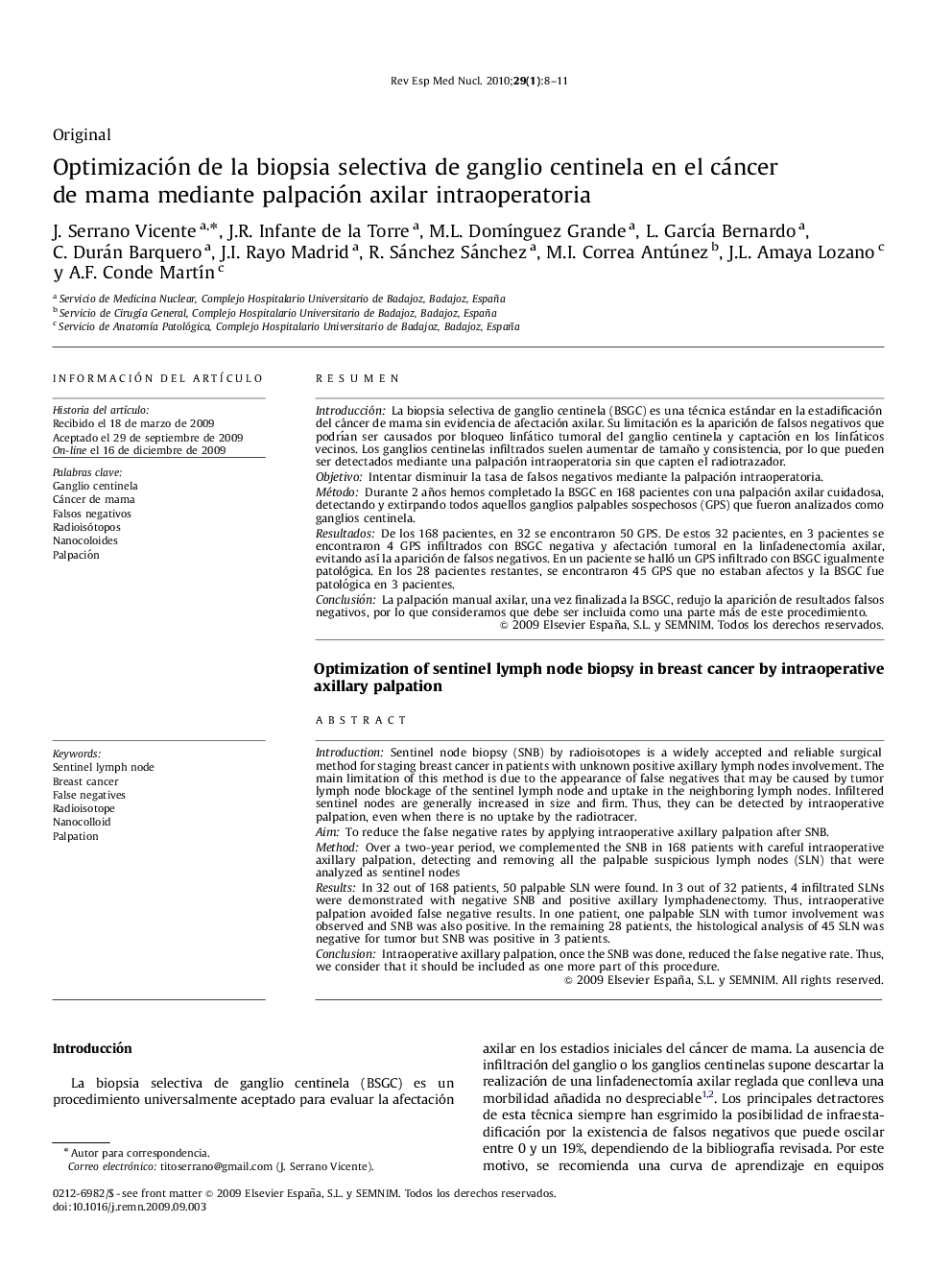| کد مقاله | کد نشریه | سال انتشار | مقاله انگلیسی | نسخه تمام متن |
|---|---|---|---|---|
| 4248974 | 1283772 | 2010 | 4 صفحه PDF | دانلود رایگان |

ResumenIntroducciónLa biopsia selectiva de ganglio centinela (BSGC) es una técnica estándar en la estadificación del cáncer de mama sin evidencia de afectación axilar. Su limitación es la aparición de falsos negativos que podrían ser causados por bloqueo linfático tumoral del ganglio centinela y captación en los linfáticos vecinos. Los ganglios centinelas infiltrados suelen aumentar de tamaño y consistencia, por lo que pueden ser detectados mediante una palpación intraoperatoria sin que capten el radiotrazador.ObjetivoIntentar disminuir la tasa de falsos negativos mediante la palpación intraoperatoria.MétodoDurante 2 años hemos completado la BSGC en 168 pacientes con una palpación axilar cuidadosa, detectando y extirpando todos aquellos ganglios palpables sospechosos (GPS) que fueron analizados como ganglios centinela.ResultadosDe los 168 pacientes, en 32 se encontraron 50 GPS. De estos 32 pacientes, en 3 pacientes se encontraron 4 GPS infiltrados con BSGC negativa y afectación tumoral en la linfadenectomía axilar, evitando así la aparición de falsos negativos. En un paciente se halló un GPS infiltrado con BSGC igualmente patológica. En los 28 pacientes restantes, se encontraron 45 GPS que no estaban afectos y la BSGC fue patológica en 3 pacientes.ConclusiónLa palpación manual axilar, una vez finalizada la BSGC, redujo la aparición de resultados falsos negativos, por lo que consideramos que debe ser incluida como una parte más de este procedimiento.
IntroductionSentinel node biopsy (SNB) by radioisotopes is a widely accepted and reliable surgical method for staging breast cancer in patients with unknown positive axillary lymph nodes involvement. The main limitation of this method is due to the appearance of false negatives that may be caused by tumor lymph node blockage of the sentinel lymph node and uptake in the neighboring lymph nodes. Infiltered sentinel nodes are generally increased in size and firm. Thus, they can be detected by intraoperative palpation, even when there is no uptake by the radiotracer.AimTo reduce the false negative rates by applying intraoperative axillary palpation after SNB.MethodOver a two-year period, we complemented the SNB in 168 patients with careful intraoperative axillary palpation, detecting and removing all the palpable suspicious lymph nodes (SLN) that were analyzed as sentinel nodesResultsIn 32 out of 168 patients, 50 palpable SLN were found. In 3 out of 32 patients, 4 infiltrated SLNs were demonstrated with negative SNB and positive axillary lymphadenectomy. Thus, intraoperative palpation avoided false negative results. In one patient, one palpable SLN with tumor involvement was observed and SNB was also positive. In the remaining 28 patients, the histological analysis of 45 SLN was negative for tumor but SNB was positive in 3 patients.ConclusionIntraoperative axillary palpation, once the SNB was done, reduced the false negative rate. Thus, we consider that it should be included as one more part of this procedure.
Journal: Revista Española de Medicina Nuclear - Volume 29, Issue 1, January–February 2010, Pages 8–11